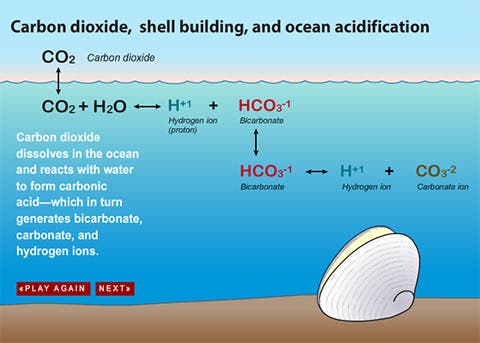Ocean acidification, one of the often ignored dangers associated with climate change is becoming increasingly worrying. As our climate becomes hotter and hotter, the oceans become more and more acidic, and this threatens some animals’ ability to create and maintain carbonatic shells.
Our research shows that within 15 years, the chemistry of these waters may no longer be saturated with enough calcium carbonate for a number of animals from tiny sea snails to Alaska King crabs to construct and maintain their shells at certain times of the year,” said Jeremy Mathis, one of the researchers, in a news release. “This change due to ocean acidification would not only affect shell-building animals but could ripple through the marine ecosystem.”
Despite what some media outlets might tell you, the science is pretty clear: humans are the main driver behind recent global warming; we’re emitting greenhouse gases, especially CO2, and they are causing our atmosphere to get hotter. But CO2 doesn’t only stay in the air – it also sinks in water. As it does so, it causes our planet’s oceans to become more and more acidic, which is why ocean acidification if often called the “evil twin of global warming” and “the other CO2 problem”. Now, researchers are already trying to estimate the amount of damage this acidification will do; spoiler alert – it’s going to be bad.
Changes in ocean chemistry can have extensive direct and indirect effects on organisms and their habitats. One of the most important repercussions of increasing ocean acidity relates to the production of shells and plates out of calcium carbonate (CaCO3). This process is called calcification and is important to the biology and survival of a wide range of marine organisms. As the acidity grows, it becomes harder and harder for these animals to produce their shells and plates, and ultimately, it might become impossible. In this latest study, the researchers collected observations on water temperature, salinity and dissolved carbon during two month-long expeditions to the Arctic. They then created a model based on their data and concluded that if current trends continue, the critical acidity will be reached in 2025 in the Beaufort Sea, 2027 for the Chukchi Sea and 2044 for the Bering Sea. When this happens, shell-building will become extremely difficult or impossible.
“The Pacific-Arctic region, because of its vulnerability to ocean acidification, gives us an early glimpse of how the global ocean will respond to increased human-caused carbon dioxide emissions, which are being absorbed by our ocean,” said Mathis. “Increasing our observations in this area will help us develop the environmental information needed by policy makers and industry to address the growing challenges of ocean acidification.”
The new study focuses only on surface waters, but the same thing might happening in the depths.
Journal Reference: Jeremy T. Mathis, Jessica N. Cross, Wiley Evans, Scott C. Doney. Ocean Acidification in the Surface Waters of the Pacific-Arctic Boundary Regions. http://dx.doi.org/10.5670/oceanog.2015.36










